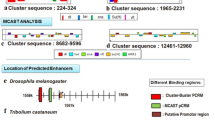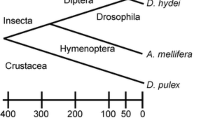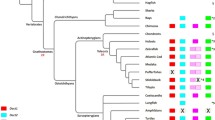Abstract
Cabut (cbt) is a Drosophila melanogaster gene involved in epidermal dorsal closure (DC). Its expression is dependent on the Jun N-terminal kinase (JNK) cascade, and it functions downstream of Jun regulating dpp expression in the leading edge cells. The Cbt protein contains three C2H2-type zinc fingers and a serine-rich domain, suggesting that it functions as a transcription factor. We have identified single cbt orthologs in other Drosophila species, as well as in other insects and invertebrate organisms like ascidians and echinoderms, but not in nematodes. Gene structure and protein sequence are highly conserved among Drosophilidae, but are more diverged in the other species of invertebrates analyzed. According to this, we demonstrate that cbt expression is detected in the embryonic lateral epidermis in several Drosophila species, as it occurs in D. melanogaster, thus suggesting that the cbt orthologs may have a conserved role in these species during DC. We have also analyzed the genomes of several vertebrate species, finding that the cbt orthologous genes in these organisms encode proteins that belong to the TIEG family of Sp1-like/Krüppel-like transcription factors. Phylogenetic analysis of the invertebrate and vertebrate proteins identified indicates that they mainly follow the expected phylogeny of the species, and that the cbt gene was duplicated during vertebrate evolution. Because we were not able to identify cbt orthologous genes neither in yeast nor in plants, our results suggest that this gene has been probably conserved throughout metazoans and that it may play a fundamental role in animal biology.





Similar content being viewed by others
References
Abascal F, Zardoya R, Posada D (2005) ProtTest: selection of best-fit models of protein evolution. Bioinformatics 21:2104–2105
Altschul SF, Madden TL, Schäffer AA, Zhang J, Zhang Z, Miller W, Lipman DJ (1997) Gapped BLAST and PSI-BLAST: a new generation of protein database search programs. Nucleic Acids Res 25:3389–3402
Barrasa MI, Harel NY, Alwine JC (2005) The phosphorylation status of the serine-rich region of the human cytomegalovirus 86-kilodalton major immediate–early protein IE2/IEP86 affects temporal viral gene expression. J Virol 79:1428–1437
Bensamoun S, Tsubone T, Subramaniam M, Hawse JR, Boumediene E, Spelsberg TC, An KN, Amadio PC (2006) Age-dependent changes in the mechanical properties of tail tendons in TGF{beta} inducible early gene-1 (TIEG) knockout mice. J Appl Phys 101:1419–1424
Burge C, Karlin S (1997) Prediction of complete gene structures in human genomic DNA. J Mol Biol 268:78–94
Cook T, Gebelein B, Mesa K, Mladek A, Urrutia R (1998) Molecular cloning and characterization of TIEG2 reveals a new subfamily of transforming growth factor-beta-inducible Sp1-like zinc finger-encoding genes involved in the regulation of cell growth. J Biol Chem 273:25929–25936
Cook T, Gebelein B, Belal M, Mesa K, Urrutia R (1999) Three conserved transcriptional repressor domains are a defining feature of the TIEG subfamily of Sp1-like zinc finger proteins. J Biol Chem 274:29500–29504
Cook T, Urrutia R (2000) TIEG proteins join the Smads as TGF-beta-regulated transcription factors that control pancreatic cell growth. Am J Physiol Gastrointest Liver Physiol 278:G513–G521
Ellenrieder V, Zhang JS, Kaczynski J, Urrutia R (2002) Signaling disrupts mSin3A binding to the Mad1-like Sin3-interacting domain of TIEG2, an Sp1-like repressor. EMBO J 21:2451–2460
Franke JD, Montague RA, Kiehart DP (2005) Nonmuscle myosin II generates forces that transmit tension and drive contraction in multiple tissues during dorsal closure. Curr Biol 15:2208–2221
Gill G, Pascal E, Tseng ZH, Tjian R (1994) A glutamine-rich hydrophobic patch in transcription factor Sp1 contacts the dTAFII110 component of the Drosophila TFIID complex and mediates transcriptional activation. Proc Natl Acad Sci USA 91:192–196
Iuchi S (2001) Three classes of C2H2 zinc finger proteins. Cell Mol Life Sci 58:625–635
Jones DT, Taylor WR, Thornton JM (1992) The rapid generation of mutation data matrices from protein sequences. Comput Appl Biosci 8:275–282
Kaczynski J, Cook T, Urrutia R (2003) Sp1- and Kruppel-like transcription factors. Genome Biol 4:206
Kaltschmidt JA, Lawrence N, Morel V, Balayo T, Fernandez BG, Pelissier A, Jacinto A, Martinez Arias A (2002) Planar polarity and actin dynamics in the epidermis of Drosophila. Nat Cell Biol 4:937–944
Kay BK, Williamson MP, Sudol M (2000) The importance of being proline: the interaction of proline-rich motifs in signaling proteins with their cognate domains. FASEB J 14:231–241
Kiehart DP, Galbraith CG, Edwards KA, Rickoll WL, Montague RA (2000) Multiple forces contribute to cell sheet morphogenesis for dorsal closure in Drosophila. J Cell Biol 149:471–490
Koonin EV (2005). Orthologs, paralogs, and evolutionary genomics. Annu Rev Genet 39:309–338
Kumar S, Tamura K, Nei M (2004) MEGA3: integrated software for molecular evolutionary genetics analysis and sequence alignment. Brief Bioinform 5:150–163
Muñoz-Descalzo S, Terol J, Paricio N (2005) Cabut, a C2H2 zinc finger transcription factor, is required during Drosophila dorsal closure downstream of JNK signaling. Dev Biol 287:168–179
Ohno S (1999) Gene duplication and the uniqueness of vertebrate genomes circa 1970–1999. Semin Cell Dev Biol 10:517–522
Okamura H, Garcia-Rodriguez C, Martinson H, Qin J, Virshup DM, Rao A (2004) A conserved docking motif for CK1 binding controls the nuclear localization of NFAT1. Mol Cell Biol 24:4184–4195
Rajamannan NM, Subramaniam M, Abraham TP, Vasile VC, Ackerman MJ, Monroe DG, Chew TL, Spelsberg TC (2007) TGFbeta inducible early gene-1 (TIEG1) and cardiac hypertrophy: discovery and characterization of a novel signaling pathway. J Cell Biochem 100:315–325
Richards S, Liu Y, Bettencourt BR, Hradecky P, Letovsky S, Nielsen R, Thornton K, Hubisz MJ, Chen R, Meisel RP, Couronne O, Hua S, Smith MA, Zhang P, Liu J, Bussemaker HJ, van Batenburg MF, Howells SL, Scherer SE, Sodergren E, Matthews BB, Crosby MA, Schroeder AJ, Ortiz-Barrientos D, Rives CM, Metzker ML, Muzny DM, Scott G, Steffen D, Wheeler DA, Worley KC, Havlak P, Durbin KJ, Egan A, Gill R, Hume J, Morgan MB, Miner G, Hamilton C, Huang Y, Waldron L, Verduzco D, Clerc-Blankenburg KP, Dubchak I, Noor MA, Anderson W, White KP, Clark AG, Schaeffer SW, Gelbart W, Weinstock GM, Gibbs RA (2005) Comparative genome sequencing of Drosophila pseudoobscura: chromosomal, gene, and cis-element evolution. Genome Res 15:1–18
Russo CA, Takezaki N, Nei M (1995) Molecular phylogeny and divergence times of drosophilid species. Mol Biol Evol 12:391–404
Saitou N, Nei M (1987) The neighbor-joining method: a new method for reconstructing phylogenetic trees. Mol Biol Evol 4:406–425
Scohy S, Gabant P, Van Reeth T, Hertveldt V, Dreze PL, Van Vooren P, Riviere M, Szpirer J, Szpirer C (2000) Identification of KLF13 and KLF14 (SP6), novel members of the SP/XKLF transcription factor family. Genomics 70:93–101
Subramaniam M, Harris SA, Oursler MJ, Rasmussen K, Riggs BL, Spelsberg TC (1995) Identification of a novel TGF-beta-regulated gene encoding a putative zinc finger protein in human osteoblasts. Nucleic Acids Res 23:4907–4912
Suske G, Bruford E, Philipsen S (2005) Mammalian SP/KLF transcription factors: bring in the family. Genomics 85:551–556
Tautz D, Pfeifle C (1989) A non-radioactive in situ hybridization method for the localization of specific RNAs in Drosophila embryos reveals translational control of the segmentation gene hunchback. Chromosoma 98:81–85
Thompson JD, Gibson TJ, Plewniak F, Jeanmougin F, Higgins DG (1997) The ClustalX windows interface: flexible strategies for multiple sequence alignment aided by quality analysis tools. Nucleic Acids Res 24:4876–4882
Triezenberg SJ (1995) Structure and function of transcriptional activation domains. Curr Opin Genet Dev 5:190–196
Tsubone T, Moran SL, Subramaniam M, Amadio PC, Spelsberg TC, An KN (2006) Effect of TGF-beta inducible early gene deficiency on flexor tendon healing. J Orthop Res 24:569–575
Wang Z, Peters B, Klussmann S, Bender H, Herb A, Krieglstein K (2004) Gene structure and evolution of Tieg3, a new member of the Tieg family of proteins. Gene 325:25–34
Yajima S, Lammers CH, Lee SH, Hara Y, Mizuno K, Mouradian MM (1997) Cloning and characterization of murine glial cell-derived neurotrophic factor inducible transcription factor (MGIF). J Neurosci 17:8657–8666
Acknowledgment
We are grateful to Rosa de Frutos for fly stocks. S. M.-D. and Y.B. were supported by fellowships from Consellería de Cultura, Educació i Ciència and from Comunidad Autónoma de La Rioja, respectively. This work was supported by grants from Ministerio de Educación y Ciencia (BFU2004-00498/BMC) and from Consellería de Cultura, Educació i Ciència (ACOMP06/116) to N.P.
Author information
Authors and Affiliations
Corresponding author
Additional information
Communicated by P. Simpson
Rights and permissions
About this article
Cite this article
Muñoz-Descalzo, S., Belacortu, Y. & Paricio, N. Identification and analysis of cabut orthologs in invertebrates and vertebrates. Dev Genes Evol 217, 289–298 (2007). https://doi.org/10.1007/s00427-007-0144-5
Received:
Accepted:
Published:
Issue Date:
DOI: https://doi.org/10.1007/s00427-007-0144-5




